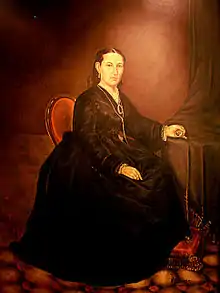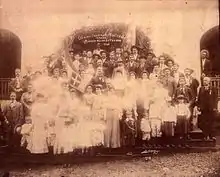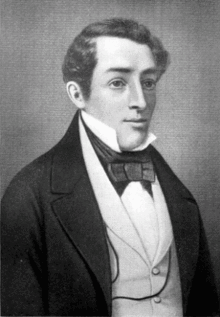Italian immigration to Mexico
An Italian-Mexican or Italo-Mexican (Spanish: italo-mexicano, Italian: italo-messicano), is a Mexican citizen of Italian descent or origin. The ancestors of most Mexicans of Italian descent arrived in the country during the late 19th century. Their descendants have generally assimilated into mainstream Mexican society.
italo-mexicanos italo-messicani | |
|---|---|
 Entrance to the Italian section of the Panteón de Dolores in Mexico City | |
| Total population | |
| 9,792 Italian nationals residing in Mexico (2019)[1] est. 85,000 Mexicans of recent Italian descent (2012)[2] | |
| Regions with significant populations | |
| Puebla · Mexico City · Nuevo León · Veracruz | |
| Languages | |
| Mexican Spanish · Italian · Chipileño | |
| Religion | |
| Roman Catholicism | |
| Related ethnic groups | |
| Other Italian diasporas |
History

During the colonial era there was a small number of non-Spanish European entrants, in particular Catholic missionaries. There are records of a few Italian soldiers and mariners in early New Spain.[3] Prominent among the Italians was Juan Pablos (born Giovanni Paoli in Brescia), who founded the first printing shop in the Americas.[3] The most important missionary was Eusebio Kino who led the evangelization of Pimería Alta.
Italo-Mexican identity rests on the common experience of migration from Italy in the late 19th century, a period characterized by a general Italian diaspora to the Americas. About 13,000 Italians emigrated to Mexico during this period,[4] and at least half returned to Italy or went on to the United States.[5] Most Italians who came to Mexico were farmers or farm workers from the northern Italian regions of Veneto, Trentino-Alto Adige/Südtirol, and Lombardy. Others, who arrived in the early 19th century, were from southern Italy. Many Italian settlers arriving in the late 19th and early 20th centuries received land grants from the Mexican government. When Benito Mussolini came to power, thousands of Italian families left Italy for Mexico.
In the state of Aguascalientes there is a large population of Mexicans of Italian descent, the result of the French incursion and the creation of the Second Mexican Empire. The regions with the greatest populations of Mexican Italians are Mexico City, Monterrey, Puebla, and Veracruz.
Society

Although Italo-Mexicans claim an Italian ethnic identity, they generally note that they are Mexican as well. In 1995, there were an estimated 30,000 Mexicans descended from Italian colonists.[6] Population figures are uncertain because, unlike other countries, Mexico's census does not gather information on specific ethnic groups. Most Italian Mexicans speak Spanish, but in Italian communities Italian and its related languages and dialects (usually mixed with Spanish) are used to communicate among themselves.
Italian community
Many Italian-Mexicans live in cities founded by their ancestors in the states of Veracruz (Huatusco) and San Luis Potosí. Smaller numbers of Italian-Mexicans live in Guanajuato, Edomex, and the former haciendas (now cities) of Nueva Italia, Michoacán and Lombardia in Michoacán, both founded by Dante Cusi from Gambar in Brescia.

Playa del Carmen, Mahahual and Cancun in the state of Quintana Roo have also received a significant number of immigrants from Italy. Several families of Italian-Mexican descent were granted citizenship in the United States under the Bracero program to address a labor shortage of labor.
Italian companies have invested in Mexico, primarily in the tourism and hospitality industries. These ventures have sometimes resulted in settlements, but residents primarily live in the resort areas of the Riviera Maya, Baja California, Puerto Vallarta and Cancun. Although they generate employment, mainly in restaurants, hotels and entertainment centers, most employees have not become permanent residents of Mexico and live as ex-pats.
Italian dialects

Most Italian immigration to Mexico occurred in the establishment of colonies. Dialects of Italian and languages of Italy which are still spoken include:
- Lower Bellunese, a dialect of the Venetian language from the Province of Belluno in Colonia Diez Gutierrez in San Luis Potosí
- The dialect of the Venetian language as spoken in the province of Treviso in the city of Chipilo, Puebla
- Lombard in Sinaloa, Colonia Manuel González, Nueva Italia and Colonia Lombardia in the state of Michoacán
- Trentino dialects of Lombard and Venetian in Colonia Manuel González, Veracruz and Tijuana, Baja California
- Piedmontese in Gutierrez Zamora, Veracruz (the oldest Italian colony in Mexico) and La Estanzuela, Jalisco, another Italian colony
- Sicilian, primarily in Mexico City, Reynosa and Monterrey
Notable Italo-Mexicans

First generation immigrants
- Marcelo Andreani, wrestler
- Cassiano Conzatti, botanist
- Riccardo Dalmacci, actor
- Adolfo Dollero, historian
- Francesca Gargallo, writer
- Filippa Giordano, singer
- Eusebio Kino, missionary
- Claudio Linati, artist
- Tina Modotti, photographer
- Nicky Mondellini, actress
- Aldo Monti, actor
- Carlos Panini, businessman
- Giovanni Paoli, printer
- Alejandro Rossi, writer
- Martha Roth, actress
- Laurette Séjourné, archeologist
- Luciano Spano, painter
- Uberto Zanolli, composer
References
- "International Migration Database". OECD. Retrieved 21 January 2021.
Country of birth/nationality: Italy, Variable: Stock of foreign population by nationality
- "Episodio 10: Italianos". Canal Once. Archived from the original on 5 March 2016. Retrieved 6 July 2015.
- Zilli Mánica, José Benigno. "De los italianos en México. Desde los "conquistadores" hasta los socios de la Cooperativa de Emigración Agrícola San Cristóforo (1924)". Universidad Veracruzana. Retrieved 24 June 2016.
- Italian statistics 2009
- http://www.everyculture.com/Middle-America-Caribbean/Italian-Mexicans-Orientation.html Italian Mexicans Orientation
- "Italian-Mexicans". Encyclopedia of World Cultures, Volume 8: Mesoamerican and the Caribbean. Retrieved 24 March 2015.
Further reading
- Bohme, Frederick G. "The Italians in Mexico: A Minority's Contribution." Pacific Historical Review 28.1 (1959): 1-18
- Gurwitz, Beatrice D. "Italian Immigrants and the Mexican Nation: The Cusi Family in Michoacán (1885–1938)." Immigrants & Minorities 33.2 (2015): 93-116.
- Zilli Manica, José Benigno. La Villa Luisa de los Italianos: Un proyecto liberal. Xalapa: Universidad Veracruzana 1997.
- Zilli Manica, José Benigno. Italianos en México: Documentos para la historia de los Colonos Italianos en México. Xalapa: Ediciones de San JoséĢ 1981.
External links
- Los que llegaron - Italianos from Canal Once (in Spanish)